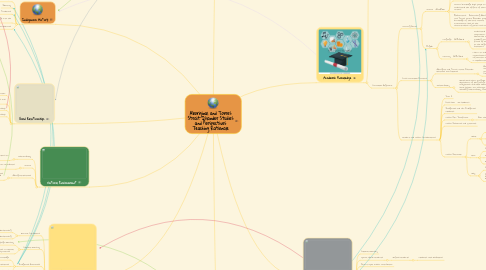
1. Natural Environment
1.1. Sustainability
1.1.1. Individual and collaborative actions to improve sustainability
1.2. Science
1.2.1. Awareness of how Science contributes to sustainability
1.3. Aboriginal Histories
1.3.1. Awareness of what Indigenous Peoples know about particular plant life and its history
2. Indigenous History
2.1. Strong Communities
2.2. Identity
2.3. Traditions
2.4. Embed deeper knowledge into the curriculum
2.5. True Histories
3. Good Relationships
3.1. Student/Peer Collaboration
3.2. Teacher/Student Relationships and Understanding
3.3. Community Relationships
3.4. Parent Relationships
4. Cultural Awareness
4.1. General Capabilities
4.1.1. Intercultural Understanding
4.1.2. Ethical Understanding
4.2. Cultural Diversity
4.2.1. Aware of Language Diversity
4.2.2. Aware of differences in cultural understandings and practices
4.3. Indigenous Awareness
4.3.1. Indigenous Knowledge
4.3.2. Indigenous Histories
4.3.3. True Histories
5. Inclusion
5.1. Cultural Diversity
5.2. Special Needs Students
5.2.1. Gifted Students
5.2.1.1. Students with Disabilities
5.3. Parent input and/or contribution
6. Collaboration
6.1. Collaborative Work Tasks
6.2. Group Work
6.3. Peer Collaboration
6.4. Student-Teacher Collaboration
7. Academic Knowledge
7.1. Learning Outcomes
7.1.1. Sustainability
7.1.1.1. Understanding effects of actions on plants
7.1.1.2. Importance of water and water saving on the natural environment
7.1.2. Literacy skills
7.1.2.1. Oral Language
7.1.2.2. Writing Skills
7.1.3. Aboriginal Histories
7.1.3.1. True Histories
7.1.4. Science Skills
7.1.4.1. Cause and Effect
7.1.4.2. Record Keeping
7.1.4.3. Observation
7.1.5. Social Skills
7.1.5.1. Collaboration
7.2. Curriculum Alignment
7.2.1. Learning Areas
7.2.1.1. Science - ACSHE051
7.2.1.1.1. Science as a Human Endeavor
7.2.1.1.2. Use and Influence of Science
7.2.1.1.3. Science knowledge helps people to understand the effect of their actions
7.2.1.1.4. Elaborations - Researching Aboriginal and Torres Strait Islander peoples knowledge of the local natural environment, such as the characteristics of plants and animals
7.2.1.2. English
7.2.1.2.1. Language - ACELA1476
7.2.1.2.2. Literacy - ACELY1676
7.2.2. Cross-curriculum Priorities
7.2.2.1. Aboriginal and Torres Strait Islander Histories and Cultures
7.2.2.1.1. Aboriginal and Torres Strait Islander communities maintain a special connection to and responsibility for Country/Place (Years 3 & 4)
7.2.2.2. Sustainability
7.2.2.2.1. World views that recognize the dependence of living things on healthy ecosystems, and value diversity and social justice, are essential for achieving sustainability (Years 3 & 4)
7.2.3. Student and Lesson Considerations
7.2.3.1. Year 3
7.2.3.2. Class size - 20 students
7.2.3.3. Indigenous and Non-Indigenous Students
7.2.3.4. Lesson Plan Timeframe
7.2.3.4.1. Over the course of 1 term
7.2.3.5. Lesson Resources and Materials
7.2.3.6. Lesson Rationale
7.2.3.6.1. What
7.2.3.6.2. How
7.2.3.6.3. Why
8. Language Diversity
8.1. Indigenous and Torres Strait Islander Languages
8.1.1. Indigenous Symbols
8.2. Other Cultures Languages
8.3. Special Needs Students - Communication
8.3.1. Hearing Impairment
8.3.2. Sight Impairment
8.3.3. Intellectual Disability
